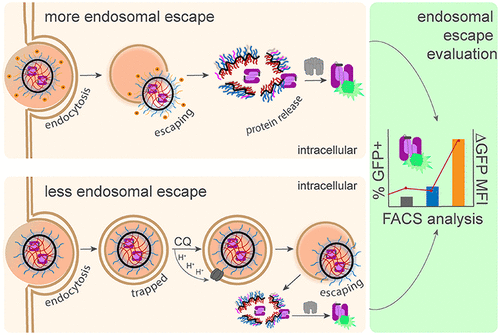当前位置:
X-MOL 学术
›
Biomacromolecules
›
论文详情
Our official English website, www.x-mol.net, welcomes your
feedback! (Note: you will need to create a separate account there.)
Evaluating Endosomal Escape of Caspase-3-Containing Nanomaterials Using Split GFP
Biomacromolecules ( IF 5.5 ) Pub Date : 2021-02-16 , DOI: 10.1021/acs.biomac.0c01767 Francesca Anson , Bin Liu , Pintu Kanjilal , Peidong Wu , Jeanne A. Hardy , S. Thayumanavan
Biomacromolecules ( IF 5.5 ) Pub Date : 2021-02-16 , DOI: 10.1021/acs.biomac.0c01767 Francesca Anson , Bin Liu , Pintu Kanjilal , Peidong Wu , Jeanne A. Hardy , S. Thayumanavan

|
The ability for biologics to access intracellular targets hinges on the translocation of active, unmodified proteins. This is often achieved using nanoscale formulations, which enter cells through endocytosis. This uptake mechanism often limits the therapeutic potential of the biologics, as the propensity of the nanocarrier to escape the endosome becomes the key determinant. To appropriately evaluate and compare competing delivery systems of disparate compositions, it is therefore critical to assess endosomal escape efficiencies. Unfortunately, quantitative tools to assess endosomal escape are lacking, and standard approaches often lead to an erroneous interpretation of cytosolic localization. In this study we use a split-complementation endosomal escape (SEE) assay to evaluate levels of cytosolic caspase-3 following delivery by polymer nanogels and mesoporous silica nanoparticles. In particular, we use SEE as a means to enable the systematic investigation of the effect of polymer composition, polymer architecture (random vs block), hydrophobicity, and surface functionality. Although polymer structure had little influence on endosomal escape, nanogel functionalization with cationic and pH-sensitive peptides significantly enhanced endosomal escape levels and, further, significantly increased the amount of nanogel per endosome. This work serves as a guide for developing an optimal caspase-3 delivery system, as this caspase-3 variant can be easily substituted for a therapeutic caspase-3 cargo in any system that results in cytosolic accumulation and cargo release. In addition, these data provide a framework that can be readily applied to a wide variety of protein cargos to assess the independent contributions of both uptake and endosomal escape of a wide range of protein delivery vehicles.
中文翻译:

使用 Split GFP 评估含 Caspase-3 的纳米材料的内体逃逸
生物制剂进入细胞内靶标的能力取决于活性、未修饰蛋白质的易位。这通常是通过使用纳米级制剂来实现的,纳米级制剂通过内吞作用进入细胞。这种摄取机制通常限制了生物制剂的治疗潜力,因为纳米载体逃离内体的倾向成为关键的决定因素。因此,为了正确评估和比较不同组合物的竞争性递送系统,评估内体逃逸效率至关重要。不幸的是,缺乏评估内体逃逸的定量工具,并且标准方法常常导致对胞质定位的错误解释。在本研究中,我们使用分裂互补内体逃逸 (SEE) 测定来评估聚合物纳米凝胶和介孔二氧化硅纳米粒子递送后胞质 caspase-3 的水平。特别是,我们使用 SEE 作为一种手段来系统研究聚合物组成、聚合物结构(无规与嵌段)、疏水性和表面功能的影响。尽管聚合物结构对内体逃逸影响不大,但用阳离子和 pH 敏感肽进行纳米凝胶功能化显着增强了内体逃逸水平,并且进一步显着增加了每个内体的纳米凝胶量。这项工作可作为开发最佳 caspase-3 递送系统的指南,因为这种 caspase-3 变体可以轻松替代任何系统中的治疗性 caspase-3 货物,从而导致胞质积累和货物释放。此外,这些数据提供了一个框架,可以很容易地应用于各种蛋白质货物,以评估各种蛋白质递送载体的摄取和内体逃逸的独立贡献。
更新日期:2021-03-08
中文翻译:

使用 Split GFP 评估含 Caspase-3 的纳米材料的内体逃逸
生物制剂进入细胞内靶标的能力取决于活性、未修饰蛋白质的易位。这通常是通过使用纳米级制剂来实现的,纳米级制剂通过内吞作用进入细胞。这种摄取机制通常限制了生物制剂的治疗潜力,因为纳米载体逃离内体的倾向成为关键的决定因素。因此,为了正确评估和比较不同组合物的竞争性递送系统,评估内体逃逸效率至关重要。不幸的是,缺乏评估内体逃逸的定量工具,并且标准方法常常导致对胞质定位的错误解释。在本研究中,我们使用分裂互补内体逃逸 (SEE) 测定来评估聚合物纳米凝胶和介孔二氧化硅纳米粒子递送后胞质 caspase-3 的水平。特别是,我们使用 SEE 作为一种手段来系统研究聚合物组成、聚合物结构(无规与嵌段)、疏水性和表面功能的影响。尽管聚合物结构对内体逃逸影响不大,但用阳离子和 pH 敏感肽进行纳米凝胶功能化显着增强了内体逃逸水平,并且进一步显着增加了每个内体的纳米凝胶量。这项工作可作为开发最佳 caspase-3 递送系统的指南,因为这种 caspase-3 变体可以轻松替代任何系统中的治疗性 caspase-3 货物,从而导致胞质积累和货物释放。此外,这些数据提供了一个框架,可以很容易地应用于各种蛋白质货物,以评估各种蛋白质递送载体的摄取和内体逃逸的独立贡献。










































 京公网安备 11010802027423号
京公网安备 11010802027423号